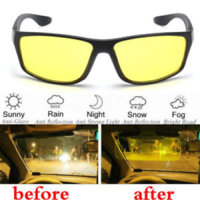It does but only a tiny amount in front of the vehicle that would only benefit you if you were travelling extremely slowly. Make the headlight themselves yellow would, in theory, actually have a useful effect, but was found not to in FranceIt could be an urban myth, but I think using yellow filters out the blue that make the reflection worse...
You are using an out of date browser. It may not display this or other websites correctly.
You should upgrade or use an alternative browser.
You should upgrade or use an alternative browser.
Led Fog Light Upgrade (dual Colour) - How I Did It -
- Thread starter Dellmassive
- Start date
Fog lights produce a short but wide beam spread which falls close to the vehicle. This allows the driver to see the edges of the road and a bit ahead without the glare of the main beam reflecting off the fog directly in front of them and, in essence, blinding the driver.
Selective yellow
From Wikipedia, the free encyclopedia
Selective yellow is a colour for automotive lamps, particularly headlamps and other road-illumination lamps such as fog lamps.[1] Under ECE regulations, headlamps were formerly permitted to be either white or selective yellow—in France, selective yellow was mandatory for all vehicles' road-illumination lamps until 1993.
Both the internationalized European ECE Regulation 19[2] and North American SAE standard J583[3] permit selective yellow front fog lamps. ECE Regulation 48 currently[when?] requires new vehicles to be equipped with headlamps emitting white light.[4] However, selective yellow headlamps remain permitted throughout Europe on vehicles already so equipped, as well as in non-European locales such as Japan[5] and New Zealand.[6]
The intent of selective yellow is to improve vision by removing short, blue to violet wavelengths from the projected light. These wavelengths are difficult for the human visual system to process properly, and they cause perceived dazzle and glare effects in rain, fog and snow.[7] Removing the blue-violet portion of a lamp's output to obtain selective yellow light can entail filter losses of around 15%,[8] though the effect of this reduction is said to be mitigated or countervailed by the increased visual acuity available with yellow rather than white light in bad weather.[7]
A research experiment done in the UK in 1968 using tungsten (non-halogen) lamps found that visual acuity is about 3% better with selective yellow headlamps than with white ones of equal intensity.[9] Research done in the Netherlands in 1976 concluded that yellow and white headlamps are equivalent as regards traffic safety, though yellow light causes less discomfort glare than white light.[10] Researchers note that tungsten filament lamps emit only a small amount of the blue light blocked by a selective-yellow filter[9], so such filtration makes only a small difference in the characteristics of the light output[7], and suggest that headlamps using newer kinds of sources such as metal halide (HID) bulbs may, through filtration, give off less visually distracting light while still having greater light output than halogen ones
From Wikipedia, the free encyclopedia
Selective yellow is a colour for automotive lamps, particularly headlamps and other road-illumination lamps such as fog lamps.[1] Under ECE regulations, headlamps were formerly permitted to be either white or selective yellow—in France, selective yellow was mandatory for all vehicles' road-illumination lamps until 1993.
Both the internationalized European ECE Regulation 19[2] and North American SAE standard J583[3] permit selective yellow front fog lamps. ECE Regulation 48 currently[when?] requires new vehicles to be equipped with headlamps emitting white light.[4] However, selective yellow headlamps remain permitted throughout Europe on vehicles already so equipped, as well as in non-European locales such as Japan[5] and New Zealand.[6]
The intent of selective yellow is to improve vision by removing short, blue to violet wavelengths from the projected light. These wavelengths are difficult for the human visual system to process properly, and they cause perceived dazzle and glare effects in rain, fog and snow.[7] Removing the blue-violet portion of a lamp's output to obtain selective yellow light can entail filter losses of around 15%,[8] though the effect of this reduction is said to be mitigated or countervailed by the increased visual acuity available with yellow rather than white light in bad weather.[7]
A research experiment done in the UK in 1968 using tungsten (non-halogen) lamps found that visual acuity is about 3% better with selective yellow headlamps than with white ones of equal intensity.[9] Research done in the Netherlands in 1976 concluded that yellow and white headlamps are equivalent as regards traffic safety, though yellow light causes less discomfort glare than white light.[10] Researchers note that tungsten filament lamps emit only a small amount of the blue light blocked by a selective-yellow filter[9], so such filtration makes only a small difference in the characteristics of the light output[7], and suggest that headlamps using newer kinds of sources such as metal halide (HID) bulbs may, through filtration, give off less visually distracting light while still having greater light output than halogen ones
My new Volvo XC40 has come with bright white LED front fogs; which surprised me, Volvo have always gone big on exterior lighting since the 1970's.
No bulb warnings today, and colour switching on the move was fine...... so all good so far.No warnings yet. Tomorrow's drive will be a better test.
Deleted Member
Account closed by request
Great post. 
How did you make the connection between the factory loom and the driver?
How did you make the connection between the factory loom and the driver?
Opticians don't sell these because we have to comply with regulations that non registered sellers don't. IE we can only sell stuff that works. I don't care whether people have yellow fog lights (as long as they only have them on in thick fog or driving snow where visibility is significantly reduced) as long as you're doing it for fashion reasons and don't kid yourself they make a difference
Opticians don't sell these because we have to comply with regulations that non registered sellers don't. IE we can only sell stuff that works. I don't care whether people have yellow fog lights (as long as they only have them on in thick fog or driving snow where visibility is significantly reduced) as long as you're doing it for fashion reasons and don't kid yourself they make a difference
yup - genuinely. I am that shallow
They come with the VW connector so they are essentially plug-and-play.Great post.
How did you make the connection between the factory loom and the driver?
thanks @Dellmassive !
No warnings yet. Tomorrow's drive will be a better test.
Nice one, thanks. Need to get some ordered.
Pete
Likey

Deleted Member
Account closed by request
I ordered the silly colour changing ones 

I ordered the silly colour changing ones
There's always one lol. Make sure you grab a video of them, interested to see the oily water effect.
I ordered the silly colour changing ones
Really want to see those
Similar threads
- Replies
- 7
- Views
- 821
- Replies
- 0
- Views
- 298
- Replies
- 0
- Views
- 482
- Replies
- 2
- Views
- 398
- Replies
- 2
- Views
- 491






